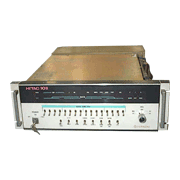The HITAC 10II was the successor of the HITAC 10 minicomputer developed by Hitachi, and was announced in 1973. Although the 16-bit word (32-bit words: optional) architecture was unchanged, the size was smaller than the previous HITAC 10 due to the use of MSI (mid-scale integrated circuits), a switching regulator and large printed circuit boards. The system could also be rack-mounted. Memory capacity of the magnetic core ranged, as before, from 4 Kword to a maximum of 32 Kword, and higher speed was achieved with a cycle time of 0.9 microseconds and an addition/subtraction speed of 1.8 microseconds. The basic input/output device was a data typewriter, and paper tape was used as portable memory media, but a variety of other devices could be connected as options, including a tape reader/puncher, card reader, magnetic drum, magnetic disk, magnetic tape and cassette MT. The available software was an assembler, compilers for FORTRAN and BASIC and various input/output subroutines. The bus interface was open to the user, and users could connect their own controllers. The system was incorporated into applications such as monitoring/control, automatic control and production line control, and a considerable number of machines were used on an OEM basis in plants and similar facilities. Later, the system developed into the HITAC 10II/A and 10II/L which had IC memory and floppy disk support.

- Home >
- Historical Computers in Japan >
- Minicomputers >
- HITAC 10II
All Rights Reserved, Copyright (C) Information Processing Society of Japan

